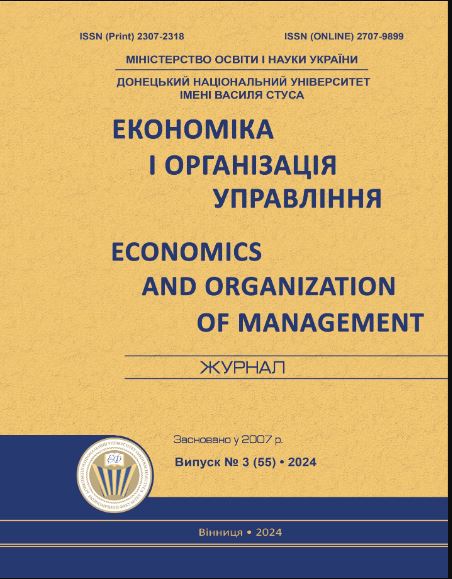Monetary policy architecture during the transition from financial stabilization to sustainable economic growth
DOI:
https://doi.org/10.31558/2307-2318.2024.3.3Keywords:
monetary policy, money supply, balance of payments, monetization, demonetization, financial stabilization, sustainable economic growth, financial systemAbstract
The article outlines approaches to determining the essence of monetary policy and its strategic goals. The main features are considered, the priorities and functional dependencies of monetary policy which are characteristic of transitional financial systems, in accordance with the classification of the transitional process as the consistent implementation of the tasks of financial stabilisation, the transition to sustainable economic growth, and subsequent anticyclical regulation after reaching a certain equilibrium level of income, are determined. The conditions for the implementation of monetary policy, which differ depending on the macroeconomic situation – financial stabilisation, transition to sustainable economic growth or anti-cyclical regulation, are substantiated. It is also substantiated that the evolution of monetary policy can be conveniently monitored with the help of indicators of the economy monetization and the real exchange rate, which can show the way of reaching the equilibrium state.
References
Atamanchuk, Z. (2011) Monetary and credit regulation and its role in security balance of income and balance of payments of the state: autoref. thesis Ph.D in economics. Lviv. 22 p.
Yaremenko, O., Lys, I.(2007) Monetization and development of inflationary processes. Strategy socio-economic development of Ukraine and priorities of monetary policy: scientific and practical materials. conf. (December 7, 2006, Kyiv). K.: NBU, Institute of Economics and Forecasting of the National Academy of Sciences of Ukraine, 138-142.
Yaremenko, O., Hrytsenko, A., Kornivska, V. (2020) Monetary and credit policy of counteraction stabilization factors. Financial and credit activity: problems of theory and practice. No. 33. Vol. 2. 442-451.
Lagutin, V., Krychevska, T. (2001) Trust in monetary policy: the choice of monetary credit strategy in Ukraine. Bulletin of the NBU. No. 11. 22-25.
Moroz, A., Pukhovkina, M., Savluk, M. (2005) Central bank and monetary policy: textbook. K.: KNEU. 556 p.
Dorn, J. (1993) Monetary Reform in Ex-Communist Countries. CATO Journal. Vol.
, 3, 509-525.
Aarle, V., Budina, N. (1995) Currency Substitution in Eastern Europe. Center for
Economic Research Discussion Paper. No 9502. Tilburg University, Netherlands, 153-169.
Cukierman, A., Liviatan, N. (1992) The Dynamics of Optimal Gradual Stabi¬li¬za¬tions.
World Bank Economic Review. Vol. 6. 3, 439-458.
De Melo, M., Denizer, C. (1997) Monetary Policy During Transition: An Overview.
Policy Research Working Paper. No 1706. Washington : World Bank. 75 p.
Marangos, J. (2003) Was Shock Therapy Really a Shock? Journal of Economic Issues.
Vol. XXXVII, 4, 943─966.
De Melo, M., Denizer, С., Gelb, С., Tenev, S. (1996) Circumstance and Choice: the
Role of Initial Conditions and Policies in Transition Economies. Policy Research Working Paper. No 714. Washington : World Bank. 75 p.
Claus, V. (1993) Creating a Stable Monetary Order. CATO Journal. Vol. 12, 3, 527-
Edwards, S. (1991) Capital and Current Account Liberalization and Real Exchange
Rates in Developing Countries. Exchange Rate Policies in Developing and Post-Socialist Countries. San Francisco : ICS Press. 243-275.
Erbas, N. (2002) Primer on Reforms in a Second-Best Ambiguous Environment: A
Case for Gradualism. IMF Working Paper. No 50. Washington: IMF. 55 p.
Loungani, P., Razin, A., Yuen, G.-W. (1997) Capital Mobility and the Output-Inflation
Tradeoff. International Finance Discussion Papers. No 577. Washington : Board of Governors of the FRS. 20 p.
Feldstein, M. (2005) Monetary Policy in a Changing International Environment : The
Role of Global Capital Flows. NBER Working Paper. No 11856. Washington : NBER. 35 p.
Horvath, B., Maino, R. (2006). Monetary Transmission Mechanisms in Belarus. IMF
Working Paper. No 246. Washington : IMF. 22 p.
Fischer, S, Sahay, R., Vegh, C. (2002) Modern Hyper- and High Inflations. Journal of
Economic Literature. Vol. 40, 3, 837-880.
Maliszewski, W. (2003) Modelling Inflation in Georgia. IMF Working Paper. 2003. No 212. Washington : IMF. 22 p.
Alimpiev, E. (2010) Financial and monetary transmission in the economy of Ukraine. Finances of Ukraine. No. 5. 23-30.
Ostrovska, N., Pryadko, V. (2009) Credit potential of commercial banks during the economic crisis. Finances of Ukraine. No. 11. 73-77.
Vovchak, O., Khmelyarchuk, M. (2010) Institutional determinants of monetary policy formation in Ukraine. Bulletin of the NBU. No. 9. 3-10.
De Melo, М., Denizer, C., Gelb, A. (1996) From Plan to Market: Patterns of Transition. Policy Research Working Paper. No 1564. Washington : World Bank, 64 p.
Zalduendo, J. (2005) Pace and Sequencing of Economic Policies. IMF Working Paper. No 118. Washington: IMF. 20 p.
Shevchuk, V. (2001) Balance of Payments and Macroeconomic Equilibrium. Lviv: Kamenyar, 2001. 495 p.
Goryunov, E (2023) The monetization of economy: An indicator that indicates nothing. Voprosy Ekonomiki. NP Voprosy Ekonomiki, Іssue 3. Available at: https://ideas.repec.org/a/nos/voprec/y2023id4120.html (accessed: 10.08.2024).

